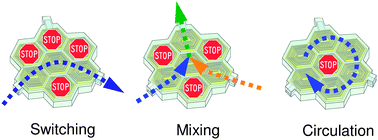This paper presents the design, fabrication, and characterization of an electrostatically actuated user-reconfigurable elastomer microfluidic system intended for very large scale integration (VLSI) microfluidics. By adding thin film metal flexures into the PDMS polymer, individual elastomer channels were made to self-close without the use of pneumatics via the application of 15–20 V, 5 MHz signals synthesized digitally by a microcontroller and a radio-frequency amplifier IC. These valves were arranged into hexagonal or quadricular arrays with 75% fill factor. During use, valves were selected to be permanently closed, permanently open or addressable; this allowed for the on-the-fly determination of channels, valves and pumps. We present characterization of flow and pressure data for valves and pumps and demonstrate various multi-component configurations of the system capable of pumping, mixing, splitting and circulating flow. The presented technology is compatible with standard PDMS microfluidics, has actuation voltages low enough to be driven by commercial CMOS IC's and can be used to displace aqueous, gaseous and lipid phases. The primary contribution of this technology is to provide a scalable non-pneumatic platform for the very large scale integration of microfluidic total analysis systems.

You have access to this article
 Please wait while we load your content...
Something went wrong. Try again?
Please wait while we load your content...
Something went wrong. Try again?


 Please wait while we load your content...
Please wait while we load your content...